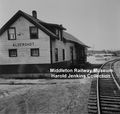Dominion Atlantic Railway Digital Preservation Initiative - Wiki
Use of this site is subject to our Terms & Conditions.
Difference between revisions of "Aldershot"
Dan Conlin (talk | contribs) m (→History) |
Dan Conlin (talk | contribs) m (→History) |
||
| (2 intermediate revisions by the same user not shown) | |||
| Line 20: | Line 20: | ||
==History== | ==History== | ||
| − | + | First known as Pine Hill, Aldershot was initially settled by a group of African families who escaped slavery in the United States during the War of 1812. The name changed to Aldershot in 1904 when the militia training base for western Nova Scotia was moved from the [[Auburn]] area to Pine Hill, with the base and the community taking the named from the famous Aldershot Army base in England.<ref>[https://archives.novascotia.ca/places/page/?ID=5 "Adlershot, Kings County", ''Place-names and Places of Nova Scotia'', Page 5]</ref> A summer militia grounds and then a full base in the First and Second World War, Aldershot became the destination for many [[Army Base Support|troop trains]] specials. Aldershot first appears on public timetables in 1914.<ref>[[1914-Land of Evangeline|Public Timetable June 29, 1914, page 9]]</ref> A wye was built to turn troop train locomotives. Additional facilities were added in both world wars which eventually included several supply warehouses located along the wye and two station buildings. The Aldershot wye was also used by DAR [[Kentville Roundhouse]] staff for testing refitted locomotives as they could be given a short run from Kentville and turned at Aldershot without disrupting mainline traffic.<ref>[[Barron,_Leon|Leon Barron]], personal communication with Dan Conlin, 2000</ref> | |
On Sept. 13, 1928, the evening Train from [[Weston]] to [[Kentville]] from the [[North Mountain Line]] with 6 freight cars and 1 passenger car derailed just past the Aldershot crossing. The passenger car and a boxcar of apples toppled over. Conductor K. Melvor seriously injured and 3 passengers received minor injuries.<ref>"D.A.R. Wreck Cars Leave Rail at Aldershot", Halifax Herald, Sept. 14, 1928, Carl Riff Collection</ref> | On Sept. 13, 1928, the evening Train from [[Weston]] to [[Kentville]] from the [[North Mountain Line]] with 6 freight cars and 1 passenger car derailed just past the Aldershot crossing. The passenger car and a boxcar of apples toppled over. Conductor K. Melvor seriously injured and 3 passengers received minor injuries.<ref>"D.A.R. Wreck Cars Leave Rail at Aldershot", Halifax Herald, Sept. 14, 1928, Carl Riff Collection</ref> | ||
Latest revision as of 15:53, 17 February 2025
Aldershot, Nova Scotia
Mile 1.6 from Kentville on the Kingsport Subdivision, the Cornwallis Valley Railway
Mile 1.6 from Kentville on the Spur Track D Kingsport after 1961
- Next Station North: Mill Village
- Next Station South: Kentville
Facilities
- Spur Irving Oil, Mile .55 (1930s)
- Aldershot Wye
- Camp Aldershot Military Station and telegraph office
History
First known as Pine Hill, Aldershot was initially settled by a group of African families who escaped slavery in the United States during the War of 1812. The name changed to Aldershot in 1904 when the militia training base for western Nova Scotia was moved from the Auburn area to Pine Hill, with the base and the community taking the named from the famous Aldershot Army base in England.[1] A summer militia grounds and then a full base in the First and Second World War, Aldershot became the destination for many troop trains specials. Aldershot first appears on public timetables in 1914.[2] A wye was built to turn troop train locomotives. Additional facilities were added in both world wars which eventually included several supply warehouses located along the wye and two station buildings. The Aldershot wye was also used by DAR Kentville Roundhouse staff for testing refitted locomotives as they could be given a short run from Kentville and turned at Aldershot without disrupting mainline traffic.[3]
On Sept. 13, 1928, the evening Train from Weston to Kentville from the North Mountain Line with 6 freight cars and 1 passenger car derailed just past the Aldershot crossing. The passenger car and a boxcar of apples toppled over. Conductor K. Melvor seriously injured and 3 passengers received minor injuries.[4]
In 1956, Locomotive 2617 derailed at Aldershot and buried itself in sand and gravel after splitting a switch on the Aldershot wye.[5]
Gallery
Aldershot Station postcard with troop train from the Aldershot base, circa 1912.
Derailment of troop train bound for Camp Aldershot in the Kentville Railyard, Sept. 9, 1913.
Aldershot Station, dated August 1943.
References and Footnotes
- ↑ "Adlershot, Kings County", Place-names and Places of Nova Scotia, Page 5
- ↑ Public Timetable June 29, 1914, page 9
- ↑ Leon Barron, personal communication with Dan Conlin, 2000
- ↑ "D.A.R. Wreck Cars Leave Rail at Aldershot", Halifax Herald, Sept. 14, 1928, Carl Riff Collection
- ↑ Gary W. Ness, The Dominion Atlantic Railway: 1894-1994, p. 94
- Dominion Atlantic Railway Employee Time Table September 25, 1949, Library and Archives Canada, PMP - HE.2804 DC
- "Time Table No. 77 For Employees June 21, 1931", Dominion Atlantic Railway, p. 3






